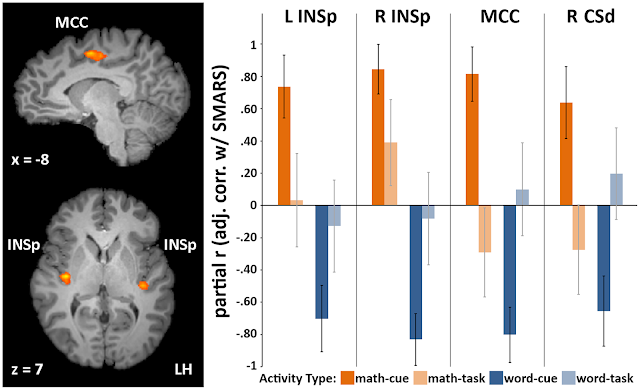 |
| A solution to eliminate math anxiety led to a journey to handling other
fears and worries. Image from Pixabay People Domain |
Overview Math Anxiety
Mathematics is a subject on school that many students face difficulties and experience panic, stress and anxiety. If not addressed in time they may develop various emotional and physical symptoms related to long term anxiety disorder and depression.
Math Anxiety is basically anxiety about one's ability to solve mathematical problems. Mark H Ashcraft, an American Academic and the chair of the Department of Psychology at the University of Nevada, Las Vegas, defines Math Anxiety as
a feeling of tension, apprehension, or fear that interferes with math performanceThe academic study of math anxiety originates as early as the 1950s, where Mary Fides Gough introduced the term mathemaphobia to describe the phobia-like feelings of many towards mathematics. The first math anxiety measurement scale was developed by Richardson and Suinn in 1972. Since this development several researchers have examined math anxiety in empirical studies.
In 1980 Tobias and Weissbrod described Math Anxiety as
the panic, helplessness, paralysis, and mental disorganization that arises among some people when they are required to solve a mathematical problem.and it is thought to affect a large portion of the population.
Dimensions of Math Anxiety
Math Anxiety is an issue we can deal with in and outside classroom. This anxiety is a negative reaction to mathematics, which can be from we getting slightly tense to being debilitated and useless. This type of anxiety can arise in many situations, not just in facing mathematical problems. Zhe Wang, assistant professor in the Texas Tech Human Development and Family Studies, clarifies, whether it be taking a math test or walking into a math class, there are variety of situations involving math that can be anxiety inducing.
She says on the situations that cause Math Anxiety to arise,
It's related to testing anxiety, but it doesn't have to be tests. They don't feel it in other situations they don't necessarily have general anxiety.
Math anxiety in social situations, such as counting out change, or calculating contribution of out dinner bill among friends, and calculation anxiety of any kind, which is the anxiety that arises while solving a math problem on an assignment or in the class, all are types of math anxiety, Wang says , people can face.
Although there are three dimensions of anxiety, they are usually highly correlated. Meaning if you experience one, you are likely experiencing another.
Disliking math and having math anxiety are two separate issues altogether and they are not similar, as someone who is good or bad at math can dislike certain aspects of the subject, Wang explains.
Symptoms of Math Anxiety
Math Anxiety manifests itself in a variety of ways, including physical, psychological and
 |
| The strong negative correlation between high math anxiety and low achievement is often thought to be due to the impact of math anxiety on working memory. |
behavioral symptoms, that can disrupt a student's mathematical performance.The strong negative correlation between high math anxiety and low achievement is often thought to be due to the impact of math anxiety on working memory. Working memory has a limited capacity and when solving mathematical problems, a large portion of this capacity is dedicated to solving problem. However in individuals with math anxiety much of this space is taken up by anxious thoughts, thus compromising the individual's ability to perform.
Symptoms of Math Anxiety include
- Emotional Symptoms : unusual nervousness, feeling helplessness, lack of confidence, fear of getting things wrong. Even thinking and talking about the subject mathematics is enough to cause stress for the student.
- Physical symptoms : racing heart, irregular breathing, nausea, sweating, stomach ailments, nail butting.
- Frustration and a feeling of being alone.
- Repeated failing to understand from where to start with questions or struggling to get the right answer.
- Confused and just wanting to quit and live alone.
- Very stressed and panicked before and during examination.
- Begin to shut down and stop listening in class.
Working Memory and Anxiety
Various studies have shown that when people of any age, experience high levels of anxiety their working memory capacity suffers. This is said to occur because more cognitive energy is devoted to manage the anxiety. Therefore executive resources experience disruption and cannot focus on elements of the working memory.
Recent study using brain scanner (fMRI) have shown that math anxiety has measurable effects on the parts of the brain used to understand math.
This means that whilst someone is in a state of anxiety, they will struggle to understand the math problems being taught or attempt questions.
 |
When Math Hurts: Math Anxiety Predicts Pain Network Activation in Anticipation of Doing Math Source https://journals.plos.org/plosone/article?id=10.1371/journal.pone.0048076 |
Lyons and Beilock,2012 states that
Bad experiences with math in the past mean that the brain sometimes associates math with pain, so the regions of the brain associated with pain processing are activated when think about math.
This only occurs when thinking about math, but doesn't occur when the brain is actually doing math. The brain may see the math as a threat, so the natural response is to run away from math in a similar way as one would run from a tiger.
Reference : Marshall, E., Mann. V., & Wilson, D. (2016). Maths anxiety: A collaboration. HEA STEMconference, Nottingham
Anxiety
Where as anxiety is a sense of fear and worry and it is not uncommon among students with math anxiety. According to Peg Rosen - a veteran parenting and family health writer, this anxiety stems from a fear of not being able to keep up with peers, as well as feeling different and worrying about the future. This issues can oftentimes interfere with a student's ability to be present in the classroom and attend to the task at hand.
Math Anxiety - Causes and Impact
There may be various reasons of math anxiety, however while addressing math anxiety in the classroom, Improving schools 17(1), 99-115, Finlayson M stated that math anxiety is usually linked with the kind of teaching styles experienced in the classroom, which often focus on memorization and rote recitation. Their early math teaching may have been from teachers who were anxious themselves thus over-compensated by emphasizing a black-and-white, right-or-wrong approach.
 |
| Poor preparation leads to poor performance which is another negative math experience, making the student more anxious as it reinforces their view that they are bad at math. |
Most affected people have had negative math experiences such as embarrassment or humiliation from failure, teachers who are insensitive or uncaring, negative attitudes about math from peers or family, and traditional rote learning rather than learning the process. Math therefore triggers negative thoughts and memories, so many math anxious students avoid math. This could mean avoiding subjects or modules they think contain math or statistics or in situations they have to study math, avoid studying until last minute. Poor preparation leads to poor performance which is another negative math experience, making the student more anxious as it reinforces their view that they are bad at math.
Working Memory Classroom Strategies
It is emphasized to build up strategies that focus on reducing anxiety as a tool to create environments that are conductive to all working memory capacities. Because high level of anxiety can further disrupt working memory function, it is important to present material in a familiar and structured format that will divide into small units of the necessary steps and tasks.
 |
Understanding math is critical. Once students realize they can do the math, the whole notion of math anxiety can be overcome.
Photo by Jonny Mansfield on Unsplash |
This helps to alleviate worry and anxiety, as well as working memory demands. The strategies below can be applied to help the students to overcome math anxiety.
- Routine and Regularity :- Daily rituals, discipline, routines allow expectation and activities to become habit and thus automatic. A consistent school, period or class schedule reduces pressure on working memory and allows students on instructions.
- Memory Aids :- Checklists and Cues are very helpful. These can be created for any activity or process. One word cue or visual may be used for performance and upcoming tasks. A card or subtle signal can help students with weak working memory skills stay on task without drawing attention to them or distracting other classmates.
- Task Break-down :- Micro-Unit and Structure - Tasks can be broken up into parts allow for things to be done in smaller steps, therefore making them more manageable for students to complete. Focusing on one step at a time can prevent students becoming overwhelmed too easily.
- Understanding Strength and Weakness :-
- Use preferred processing method - a teacher should be friendly with the students' strengths by providing instructions and materials in a manner that best fits a variety of students, learning styles (visual, auditory, kinaesthetic) . This allows all students to feel comfortable in the classroom.
- Reinforce what works - working memory is similar to a muscle; the more we use it , the better it works. Practice and repeat strategies that work best for students to encourage independent application.
- Use Visuals - visuals provide students with a format that is often easier to process and remember than spoken and written words
- Technology as an Aid :- Assistive Technology can be incredibly helpful in supporting learning and instruction by alleviating some working memory demands. Appropriate technological tools help students to better manage large amounts of information, which in turn reduce anxiety.
In order to approximately manage anxiety and allow students with varying working memory capacities Landmark School pioneered Six Teaching Principles which are widely regarded. To learn more click here
Overcoming Math Anxiety
Even though math can be difficult for multiple reasons. One cannot improve if she or he does not make any effort to learn from class materials or ask for help.Avoiding math or statistics is becoming increasingly hard given in the most competitive environment we are heading now. However, math anxiety can be overcome within a nurturing environment, recognizing and controlling the anxiety and by accepting that math requires practice rather than inbuilt ability.
 |
Teachers and parents have an important part to ensure students understand the math being presented to them
Photo by Michel Porro on Unsplash |
Understanding Math
Many of the students with math anxiety demonstrate an over reliance on procedures in math as opposed to actually understanding the math. When they try to memorize procedures, rules and routines without much understanding, the math is quickly forgotten and panic soon sets in.
Think of math as memorizing procedures - what if we forget a few? Therefore with this type of strategy, a good memory will help, but, what if we don't have a good memory. Understanding math is critical. Once students realize they can do the math, the whole notion of math anxiety can be overcome. Teachers and parents have an important part to ensure students understand the math being presented to them.
Positive Reinforcement
Students with math anxiety need to feel that they can excel at math. Parents and teachers need to review home-task with them point out all the questions she or he got right. Putting an emphasis on correct answers rather than mistake makes all the difference. However positive environment and attitudes come with quality teaching for understanding which often not available with many traditional approaches to teaching mathematics and statistics.
Asking Questions
Ask question whenever needed is good approach until the instructions is clear. It is applicable for the students and also for the parents and teachers. Parents and teachers need to understand whether their illustrations and or demonstrations or simulations are clear with the students.
 |
Parents and teachers need to understand whether their illustrations
and or demonstrations or simulations are clear with the students.
Photo by Nicole Honeywill on Unsplash
|
Practice Math
Students must not just read over notes - do the math. Practice regularly, we must make ourselves sure that we can honestly state that we understand what we are doing. Math anxiety conjures up fear of some type. For the most part, math anxiety is the fear about doing the math right, our minds draw a blank, and we think we'll fail and of course the more frustrated and anxious our minds become, the greater the chance for drawing blanks. But regular practice makes us stronger, builds confidence and we can easily overcome the fear of drawing blank and make us perfect.
Get a Tutor
When total understanding escapes us, we may opt for hiring a tutor. Teachers can have a great impact on our feelings about math. Even if the school teacher is enthusiastic about math, supplement teaching with a good and qualified tutor. Tutors can provide personal attentions that is hard to get at school. Tutors can look after personalized problems and help understanding and conceptualizing math differently.
Call a Friend
Call and work with peers who understand math. Study and practice math jointly or in a group is very
 |
We should request her or him for joint practice if possible, build confidence and
have fun in doing math, make the environment easy and positive and
overcome anxiety about math.
Photo by Dustin
Belt on Unsplash
|
effective. We must share our feeling, worry about math with our chosen friends and ask for their help in understanding math. Sometime a different approach gives huge relief. Request her or him for joint practice if possible, build confidence and have fun in doing math, make the environment easy and positive and overcome anxiety about math.
Anxiety Reappraisal
The most significant people in a child's life are parents and teachers, which signifies they have the biggest influence in the child's life.
If either parents or teachers express negative attitudes about math or about the performance of the children, they can grow up believing math ability innate and success is tied to giftedness.
A simple solution for math anxiety may be possible by re-framing it. Instead of expressing nervousness, parents and teachers should express excitement, how the child is progressing.
It may sound counter-intuitive but several research papers say it works wonder.
Practice other tools like EFT
Dr Katie Nall advocates in her TedTalk show that EFT or Emotional Freedom Technique as a possible remedy to overcome Math Anxiety. However This technique lacks sufficient scientific evidences. While some of the advice we may find helpful but surely it is not to be considered as medical advice. .
A solution to eliminate math anxiety led to a journey to handling other fears and worries. Emotional Freedom Technique (EFT or Tapping) proves to be a powerful method to deal with emotional challenges. Dr. Nall earned her Ph.D. in Mathematics Education in 2011 from Florida Institute of Technology while she worked full-time, authored her book, “CR8 UR F8”, and tried to keep it all together. While researching for her dissertation, Dr. Nall looked for a solution to help students who had fear, worry, and anxiety about taking college level math classes. It was this topic that led Dr. Nall to find a way to help not only students, but also others eliminate fear, worry, and anxiety using a new and exciting method. Dr. Nall is a Certified Practitioner in Emotional Freedom Technique (EFT or tapping) to assist others in overcoming fear, anxiety, and stress.
Practice Mindfulness
Since math anxiety is a certain degree of mental illness associated with combination of various factors, mindfulness practice is a great aid to overcome math anxiety like other related ailments like Stress, Anxiety and Depression, PTSD etc.
Mindfulness, Awareness, Consciousness, Wakefulness, Living in the moment, Being in the now, Appreciating the present, Stopping and smelling the roses. These many names describe a deceptively simple concept.
To be mindful means to pay attention to the present moment, to be aware of what we are thinking, feeling and doing as well as what is happening around us.
To be mindful means to give our mind a break from rehashing the past or worrying about the future. Instead, we appreciate and accept the present.
To be mindful means to realize that our lives consist of moments, and that each present moment is what we have.
 |
To be mindful means to give our mind a break from rehashing the past or
worrying about the future. Instead, we appreciate and accept the
present.
Photo by Jared Rice on Unsplash |
Our mind wander constantly.
Many different philosophers have developed concepts of mindfulness as well as strategies for cultivating it.
In general, meditation is the primary practice through which we learn mindfulness.
There are numerous forms of meditation and countless ways to encourage a more mindful attitude in oneself.
Find one suitable and parents should start practice along with their child and relax. Meditate, even if for 10 minutes will do.
Reflect on our goals for the day and affirm our compassion, patience, and loving kindness towards all beings.
Next is breathing. Deep breathing practice is very commonly used to nurture our inner state and give intense peace in mind before our work, while doing work and post work. Two or three long inhale and exhale reduce our tension immediately. We must adopt one breathing technique and practice with our child so she or he feel comfortable in school and perform better.
Eating Mindfully - as renowned Buddhist teacher Thich Nhat Hanh reminds us
eating is a meditative practice
We must set aside all distractions, turn off the TV, put phone out of the sight, close any book, magazine etc. Take this time to focus on the meal, relish and enjoy.
Realize all that has happened to make this meal possible: the farmers who grew the food, the rain that watered it as it grew, all the people and events that came together to make this meal possible.
Express gratitude and appreciation for our meal. This practice is quite similar to the Christian habit of saying grace before eating—in both cases, we acknowledge our good fortune and extend compassion to those who do not have adequate food.
Gratitude is the great way to reduce and overcome any kind of anxiety.
Final Thought
Various studies considered behavioral techniques to reduce mathematics anxiety, Researchers studied how expressive writing could help reduce mathematics anxiety before a class or test.
Expressing anxiety through writing before a test, class or any academic situation to unload stress is the focus of the study. When a person thinks too much about the stress of an upcoming test or class, the overthinking interferes with that person’s thought processes.
Regardless of any techniques one can use to alleviate her or his math anxiety, making any amount of effort could be beneficial for some students.We got the idea from a math chat on Twitter, and I loved it! Give students 5 minutes no pencil to discuss the assessment before they take it.Eased test anxiety&walking around hearing the student discussion was so valuable. What a great idea! Let me know how it goes @CoppockMrs pic.twitter.com/t1APhbFVF5— Colleen Johansen (@mathteachmrsj) February 27, 2019
Abubakarr Yillah, first-year Ph.D student in applied mathematics from The Gambia, West Africa and coordinator of the Tech Department of Mathematics and Statistics Tutoring and Study Center says,
anyone can face mathematics anxiety.
When you see a problem, even if you can’t solve it immediately, you’ll always have that fear that you will not be able to solve it,
But if you spend time on it, that anxiety starts going away.
Related Posts from this Blog
 |
The Vocabulary of Emotions |
 |
My understanding of the Law of Attraction through the movie Nil Battey Sannata |
 |
Anxiety and Depression - Causes, Symptoms and Remedies |
 |
Stress: Facts, Causes and Remedies |
 |
Post-Traumatic Stress Disorder (PTSD) - Symptoms. Causes and Self-Help |
 |
Why We Need to Know the Power of Resilience |
 |
Recognizing and Living with Dyslexia |
 |
Phenomenon of Left-brained and Right-brained Functions |


























